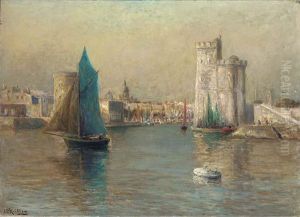J. L. Hullier Paintings
J. L. Hullier, born Jean-Louis Hullier in 1820 in France, was an artist whose work remains relatively obscure in the broader spectrum of 19th-century European art, yet it carries significant historical and cultural value. His life spanned a turbulent period in French history, marked by political upheaval, the rise of industrialization, and significant social changes, all of which influenced the art of the time. Hullier's contributions, though not widely recognized in mainstream art history, provide insight into the era's artistic movements and the socio-political context.
Hullier's artistic journey began in a France where Romanticism was giving way to Realism, and later, Impressionism. These movements sought to capture the reality of life, the natural world, and the fleeting moments of light and color, in contrast to the idealized and dramatized narratives of Romanticism. Although specifics about his education and training are scarce, it is evident from his surviving works that Hullier was adept in the techniques prevalent at the time and that he might have been influenced by the likes of Eugène Delacroix, a leading Romantic artist, as well as by Realists like Gustave Courbet and Jean-François Millet.
Hullier's oeuvre is not extensive, but the pieces that do exist show a keen observation of daily life and a predilection for landscape and genre painting, reflecting the Realist ethos of depicting the world truthfully and without embellishment. His work occasionally touched on social issues, albeit in a less confrontational manner than Courbet. Like many artists of his era, Hullier faced the challenge of balancing artistic integrity with commercial success, navigating the preferences of art patrons and the public.
The events of 1848 in France, a year marked by revolution and the establishment of the Second Republic, profoundly impacted artists of the time. Hullier, living through these upheavals, would have found himself in a society questioning its values, identity, and future. This period of political and social ferment likely influenced his thematic choices and stylistic development, pushing him to explore subjects that resonated with the changing times.
Hullier's death in 1867 came as Paris was preparing for the Exposition Universelle, a world's fair that celebrated the achievements of the Second Empire under Napoleon III and showcased the latest in arts and technology. His passing before this event meant he missed an opportunity for greater recognition and to witness the full flourish of Impressionism, a movement that would redefine art in the latter part of the 19th century. Today, J. L. Hullier's work is studied by those interested in the nuances of this transformative period in French art, offering glimpses into the lesser-documented lives and perspectives of the era.
